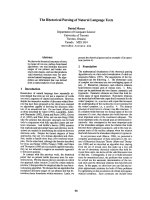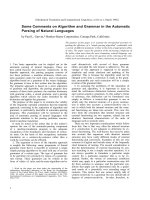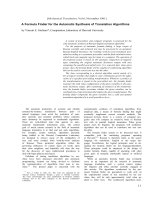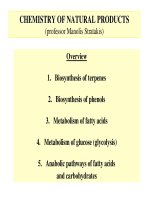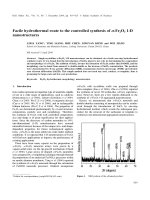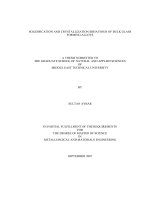Volume 4 the total synthesis of natural products
Bạn đang xem bản rút gọn của tài liệu. Xem và tải ngay bản đầy đủ của tài liệu tại đây (21.24 MB, 615 trang )
THE TOTAL SYNTHESIS
OF NATURAL PRODUCTS
The Total Synthesis
of Natural Products
VOLUME 4
Edited by
John ApSimon
Department of Chemistry
Carleton University, Ottawa
A WILEY-INTERSCIENCE PUBLICATION
JOHN WILEY & SONS,
New York
0
Chichester
Brisbane
0
Toronto
Copyright 0 1981 by John Wiley & Sons, Inc.
All rights reserved. Published simultaneously in Canada.
Reproduction or translation of any p a t of this work
beyond that permitted by Sections 107 or 108 of the
1976 United States Copyright Act without the permission
of the copyright owner is unlawful. Requests for
permission or further information should be addressed to
the Permissions Department, John Wiley & Sons, Inc.
Library of Congress Cataloging in Publication Data:
ApSimon, John.
The total synthesis of natural products.
Includes bibliographicd references and index.
1. Chemistry, Organic-Synthesis. I. Title.
QD262.A68
547'.2
12-4075
ISBN 0-471-05460-7 (v. 4)
10 9 8 7 6 5 4
3 2
Contributors
to Volume 4
Yvonne Bessihre, University of Lausanne, Lausanne, Switzerland
Jasjit S . Bindra, Pfizer Central Research, Groton, Connecticut
Kenji Mori, University of Tokyo, Bunkyo-ku, Tokyo, Japan
Raj K. Razdan, SISA Incorporated, Cambridge, Massachusetts
Alan F. Thomas, Firmenich SA, Geneva, Switzerland
Wendell Wierenga, The Upjohn Company, Kalamazoo, Michigan
V
Preface
Throughout the history of organic chemistry, we find that the study of natural
products frequently has provided the impetus for great advances. This is certainly true in total synthesis, where the desire to construct intricate and complex
molecules has led to the demonstration of the organic chemist’s utmost ingenuity in the design of routes using established reactions or in the production of
new methods in order to achieve a specific transformation.
These volumes draw together the reported total syntheses of various groups
of natural products and commentary on the strategy involved with particular
emphasis on any stereochemical control. No such compilation exists at present,
and we hope that these books will act as a definitive source book of the successful synthetic approaches reported to date. As such, it will find use not only with
the synthetic organic chemist but also perhaps with the organic chemist in
general and the biochemist in his specific area of interest.
One of the most promising areas for the future development of organic chemistry is synthesis. The lessons learned from the synthetic challenges presented by
various natural products can serve as a basis for this ever-developing area. It is
hoped that these books will act as an inspiration for future challenges and outline the development of thought and concept in the area of organic synthesis.
The project started modestly with an experiment in literature searching by a
group of graduate students about thirteen years ago. Each student prepared a
summary in equation form of the reported total syntheses of various groups of
natural products. It was my intention to collate this material and possibly
publish it. During a sabbatical leave in Strasbourg in 1968-69, I attempted to
prepare a manuscript, but it soon became apparent that the task would take
many years and I wanted to enjoy some of the other benefits of a sabbatical
leave. Several colleagues suggested that the value of such a collection would be
enhanced by commentary. The only way to encompass the amount of data
Vii
viii
Preface
collected and the inclusion of some words was to persuade experts in the various
areas to contribute.
Volume 1 presented six chapters describing the total synthesis of a wide
variety of natural products. The subject matter of Volume 2 was somewhat
more related, being a description of some terpenoid and steroid syntheses.
Volume 3 concentrated on alkaloid synthesis and appeared in 1977. The present
volume contains three chapters on new areas of synthetic endeavor and two
more encompassing the progress in synthetic work in the areas of monoterpenes
and prostaglandins since the appearance of Volume 1.
It is intended that Volume 5 of this series will contain predominantly updating chapters in order that this series may continue to be of timely use to
those with interests in synthetic chemistry.
John ApSimon
Ottawa, Canada
March 1981
Contents
The Synthesis of Insect Pheromones
1
KENJIMORI
The Total Synthesis of Cannabinoids
185
RAJK. RAZDAN
The Total Synthesis of Ionophores
263
WENDELL WERENGA
The Synthesis of Prostaglandins
353
JASJK S. BINDRA
The Synthesis of Monoterpenes, 1971-1979
451
ALAN F. THOMASand YVONNEBESSSRE
Index
593
THE TOTAL SYNTHESIS
OF NATURAL PRODUCTS
The Total Synthesis of Natural Products, Volume4
Edited by John ApSimon
Copyright © 1981 by John Wiley & Sons, Inc.
The Synthesis
of Insect Pheromones
KENJI MOM
Department of Agriculturol Chemistry,
The University of Tokyo,
Bunkyo-ku, Tokyo, Japan
1. Introduction
2. General Methods
A. Synthesis of (Q-Alkenes
B. Synthesis of (a-Alkenes
C. Carbon-Carbon Bond Formation
D. Other Useful Methods
3. Alkanes as Pheromones
4. Pheromones with an E-Double Bond
5. Pheromones with a 2-Double Bond
6. Pheromones with a Conjugated Diene System
7. Pheromones with a Nonconjugated Diene System
8. Pheromones with a Triene System
9. Pheromones with a Carbonyl Group (Aldehydes and Ketones)
10. Pheromones with an Intramolecular Ketal Linkage
11. Monoterpenoid Pheromones
12. Pheromones Belonging to Homomonoterpenoid, Sesquiterpenoids,
Degraded Sesquiterpenoids, and Diterpenoids
13. Queen Substance of Honeybee
14. Heterocycles as Pheromones
15. Optically Active Pheromones
16. Conclusion
References
2
6
6
9
10
12
15
18
20
31
42
54
57
67
86
90
102
106
109
168
168
1
2
The Synthesis of Insect Pheromones
1 . INTRODUCTION
Man has wondered at spectacular scenes of metamorphosis, aggregation, and
mating of insects for many years. During the past two decades it has gradually
become clear that these biological phenomena are regulated by chemical substances known as insect hormones and pheromones. Insect chemistry, the study
of natural products of insect origin, is now regarded as an established branch of
natural products chemistry,
After the discovery of bombykol 1, the first insect pheromone, by Butenandt
and his associates,’ the term “pheromone” was defined by Karlson and Luscher.2
The name is derived from the Greek phrein, to transfer, and hormon, to excite.
Pheromones are substances that are secreted to the outside by an individual and
received by a second individual of the same species, in which they release a specific reaction, for example, a definite behavior or a developmental process.
From the beginning the synthetic approach was very important in pheromone
researches because of the limited availability of natural pheromones from insects
(usually less than several milligrams). Synthetic work in insect pheromones may
be classified into three categories: (1) synthesis as the final proof of the proposed structure, including olefin geometry and relative as well as absolute stereochemistry; (2) synthesis that provides sufficient material for biological study,
such as field tests; and (3) synthesis of a number of isomers and analogs to clarify the structure-pheromone activity relationship. Synthesis thus ensures ample
supplies of otherwise inaccessible pheromone and facilitates the practical uses of
pheromones in agriculture and forestry.
Pheromone structures are scattered among various types of volatile compounds
ranging from alkanes to nitrogen heterocycles. Recent studies on structure-activity relationships reveal the importance of stereochemistry in pheromone perception by insects. Three types of isomerism, structural, geometrical, and optical,
are all shown to effect the biological activity, as described below.
Bombykol, the Pheromone ofthe Silkworm Moth (Bombyx mori), and its
Geometrical Isomers
Butenandt et al.394 and Truscheit and Eiter’ synthesized all of the four possible
geometrical isomers of bombykol 1 and compared their attractancy to the male
silkworm moth. The results are shown in Table 1. The biological activity, as well
as physical properties, of (1 Oh‘, lzz>-lO,I2-hexadecadien-1-01 was almost identical with that of the natural bombykol. The geometry of the diene system in
bombykol was thus established as IOE, 1 2 2 by this synthetic work. It should be
noted that the other three geometrical isomers possess only moderate or weak
biological activities. A highly stereoselective synthesis of the most active isomer
is therefore of paramount importance both scientifically and economically.
1. Introduction
3
Table 1. Biological Activity of Natural Bombykol and Synthetic Geometrical
Isomers of 10,12-Hexadecadien-l-o1
Activity (pg,/ml)'
102,122
1 0 2 , 12E
10E, 1 2 2
10E, 12E
Natural bombykol
Butenandt3
Butenandt4
1
10-3
1
10-
Eiter'
-
10"
10-l2
1o - I 2
10-l2
10
1o-l0
100
1o-'O
10
10-l0
~
'The activity is expressed by die Lockstoffeinheit(LE). This is the lower limit of
the pheromone concentration (pglml) to which 50% of the test insects show
reaction.
n-Pr C=C-C=C-(
H H H H CH2)gOH
(102. 1 2 1 )
-1
H
H
n-PrC=C-C=C-(CH2)gOH
H
H
(lOE, 12E)
- l-
H
H H
n-Pr C=C-C=C-(CH2)gOH
H
( l O Z , 12E)
-
H H
EtC=C-(CH2)100Ac
2
I
H H H
n-Pr C=C-C=C-(CH2)SOH
H
(10E. 122)
-
i-(Banbykol)
H
EtC=C-(CHZ 11 oOAc
H
3
-
The Pheromone of Red-banded LeajRoller (Argyrotaenia velutinana) and Its
Geometrical Isomer
Roelofs et al. identified (a-1
I-tetradecenyl acetate 2 as the sex pheromone of
red-banded leaf roller m o h 6 They then demonstrated that a large amount of
the @)-isomer 3 is inhibitory to pheromone action: Here again stereochemistry
was shown to be important. Roelofs' argument on this subject was based on his
bioassay results with many pheromone analogs, some of which work in an inhibitory manner, while others act ~ynergistically.~Subsequently Klun et aL8 and
4
The Synthesis of Insect Pheromones
Beroza et al.’ reported the very interesting observation that a small amount of
opposite geometrical isomer was critical to pheromone attraction. Klun found
that a geometrically pure preparation of 2 was very weakly attractive to the moth
and that the presence of 7% of (E)-isomer 3 was necessary for maximum activity.8 Previous syntheses of 2 employed either the Wittig reaction or the Lindlar
semihydrogenation, and neither of them was 100% stereoselective. It is therefore
obvious that a highly pure geometrical isomer is required to study this kind of
very subtle biological phenomena. Beroza’s relevant work was on the pheromone
of the oriental fruit moth Grapholitha molesta. The biological activity of the
synthetic pheromone (2)-8-dodecenyl acetate increased 25 times by the addition
of a small amount of the (E)-isomer.’
Gossyplure, the Pheromone of Pink Bollworm Moth (Pectinophora gossypiella)
In the case of gossyplure the pheromone consists of a mixture of two geometrical
isomers in an equal amount: (72, 112)-7,1l-hexadecadienyl acetate 4 and its
11E-isomer 5.” Neither is biologically active alone, This suggests the existence
of two different receptor sites on the pheromone receptor of the pink bollworm
moth.
The Pheromone of Dendroctonus Bark Beetles
[3.2.1] octane were
Two stereoisomers of 7-ethyl-5-methyl-6,8-dioxabicyclo
isolated from the frass of the western pine beetle (Dendroctonus brevicomis).”
Only one of them, exo-brevicomin 6, is biologically active as a component of the
aggregation pheromone of the western pine bettle. The other isomer, endo-brevicomin 7, is inactive to the western pine beetle and even inhibits the olfactory
response of flying male and female southern pine beetles (Dendroctonus frontalis) to the female-produced phtromone, frontalin 8.l’ In this case the endo-exo
stereoisomerism is of utmost importance for biological activity. This necessitated
the stereoselective synthesis of these pheromones.
P
.7.”
8
OH
1. Introduction
5
Biological Activities of the Optical Isomers of Pheromones
exo-Brevicomin 6 and frontalin 8 are chiral molecules. They therefore can exist
in two enantiomeric forms. Both enantiomers of these pheromones were synthesized, ensuring biological evaluation of the isomer^.'^^ l4 The biologically active
isomers were ( l R , 5S, 7R)-(+)-exo-brevicomin 6 and (IS, 5R)-(-)-frontalin 8.15
In these cases only one enantiomer of the two optical isomers possesses pheromone activity.
Sulcatol is the aggregation pheromone produced by males of Gnathotrichus
sulcatus.I6 Both (+)-sulcatol [(S)-9] and (-)-isomer [(R)-9] were ~ynthesized.'~
Surprisingly, neither of them was biologically active, However, when combined
to give a racemic mixture the synthetic sulcatol was more active than the natural
pheromone, which was a mixture of 65% of (S)-9 and 35% of (R)-9.'* This
situation is somewhat similar to that encountered in the case of gossyplure and
suggests the presence of enantiomer-specific active sites on receptor proteins in
the same or different cells of Gnathotrichus sulcatus. These examples illustrate
the importance of stereochemistry in pheromone researches.
The aim of this chapter is to provide a compilation of synthetic works on
pheromones. As one of the major synthetic problems in this field is the stereoselective construction of olefinic linkages, Section 2 deals mainly with preparative methods for disubstituted olefins. Then synthesis of individual pheromones
is detailed according to a classification based on the type of compound and
functional groups present. As the trend in modern organic synthesis is to develop new methods for providing chiral molecules in a stereocontrolled manner,
synthesis of chiral pheromones are treated comprehensively. It is hoped that this
chapter will be useful not only to synthetic chemists but also to entomologists
who wish to prepare pheromones of particular interest to them.
There are a number of monographs and reviews on pheromones. Especially
noteworthy is the recent chapter on Insect Chemistry in Annual Reports on the
Progress of Chemistry, which is a thorough survey on pheromone chemistry.Ig' 2o Four reviews on pheromone synthesis are available: Katzenellenbogen's
review focuses on the methodological point of view21;Henrick discusses selected
pheromones (Lepidoptera, Coleoptera, and Diptera) in depth2*; and Rossi
reviews the synthesis of both achiralZ3 and ~ h i r a pheromones.
l~~
Aspects of
pheromone chemistry is reviewed in Refs. 25-29. For those who are interested
in pheromone biology and its application a plethora of monographs and reviews
is available: e.g., Refs. 30-32 (general treatises) and Refs. 33-35 (insect behavior
and the practical application of pheromones). Bark beetle pheromones are reviewed in Refs. 36-40. References 41 and 42 are concerned with the terpenoid
pheromones, and Ref. 43 is a readable review on the pheromone receptor of
moths.
6
The Synthesis of Insect Pheromones
2. GENERAL METHODS
Before the advent of pheromone and juvenile hormone chemistry the stereoselective construction of di- and trisubstituted olefins was of only limited interest to oil and terpene chemists. During the past decade the situation haschanged,
and we now have many ingenious new methods as well as modifications of older
methods for olefin synthesis. References 44 and 45 are excellent reviews on the
stereoselective synthesis of olefins. In this section reactions that have been used
or may be useful in pheromone synthesis are presented. Synthetic methods for
trisubstituted olefins are omitted, since they are the theme of another review on
juvenile hormone synthesis?6
A. Synthesis of Q-Alkenes
Metal-AmmoniaReduction of Alkynes
The reduction of alkynes with sodium in liquid ammonia is the standard method
(Equation
Warthen and Jacobson recommend the use of a large volume of
liquid ammonia to minimize the recovery of the starting a l k y n e ~ . ~ ~
Lithium Aluminum Hydride Reduction of Alkynes
The reduction of 2-alkyn-1-01s to 2-alken-1-01s with lithium aluminum hydride
in ether usually proceeds in an excellent yield (Equation 2).49 Other alkynols
such as 3-alkyn-1-01, 7-alkyn-1-01, and 8-alkyn-1-01 can also be reduced to the
corresponding alkenols by reacting them at 140" for 48-55 h , under nitrogen,
with a large excess of lithium aluminum hydride in a mixture of diglyme and
tetrahydrofuran (Equation 3).50
ether
fH2
OH
140'
(694%)
>
H,
HZO
'
H
L i A l H 4 I dlglyrne-THF
RCEC-(CH2),
/o,
/*'\
\
LiAIH1
A
ReCCHzOH
H
R-C=C-(CH2
),OH
H
n= 2,6.?
R
,c=c
,CH2OH
'H
(2)
(3)
Reductive Elimination of Ally lic Substituents
3-Alken-1-01s can be prepared from alkynes by the route shown in Equation 4.
The key stereoselective step (97% E ) is the reductive elimination of the allylic
(L)
I
!
tr
1
8
The Synthesis of Insect Pheromones
Utilization of Organoaluminum Compounds
Disubstituted (E)-alkenes can be prepared by the reaction of (E)-alkenyl trialkylaluminates with alkyl halides and sulfonates (Equation 8).” The yield is good
(44-79%) for allylic halides and moderate (4144%) for primary halides.
Secondary and tertiary halides gave poor results. (@-Vinyl iodides are obtainable
in 94% stereoselectivity, as shown in Equation 9.” Reaction with lithium dialkylcuprate (R,CuLi) converts the iodide to (Q-alkene. A vinylalane is converted to (@-homoallylic alcohol in the yield of 81-88% (Equation
ii-BuI2A1H
n-BuCsCH
11
0
a
, BujN,
-15”
2 1 10% HCI
>
n-Bu
H
>c=c’
R\
,c=C\
H
>
H
n- Bu
‘2
(9)
‘Al(i-Bu 12
/H
(10)
(CH$2OH
Utilization of Organotin Compounds
-
(@-Allylic alcohols can be prepared from propargylic alcohol via an organotin
compound (Equation 1
H
,
(n-Bu)pH
HC3CCH2OTHP
:n-Bu)3Sn/
c=c
,CH2OTHP
‘H
n-hLi
H
,
- /CHzOTHP
/c--c\H
Li
Utilization of Organoboranes
(E)-Alkenes are prepared by the reaction of boranes with palladium acetate
(Equation 12).6’ (E, E)-Conjugated dienes are obtainable via hydroboration
(Equation 13).62
R-CECH
R;BH
H
Pd(OAcI2
/c=c
BR2
Et3N, THF
(12)
2. GeneralMethods
9
Utilization of OrganozirconiumCompounds
(E, @-Conjugated dienes are synthesized by the palladium-catalyzed reaction of
(a-1
-alkenylzirconium derivatives with alkenyl halides (Equation 14).63
Reduction of p-Acetoxysulfones
(E)-Alkenes are obtained by reduction of P-acetoxysulfones with sodium amalgam (Equation 15).@
-
n - C 7 H l ~0C H 5 0 2 P h
t
n - CgH13CHO
AcpO
M8Br
Na-Hg
EtOAc-MeOH
-200
'
Ph502
n - ~ i f 5! 7 4 ! 4 n - c 6 h 3
OAc
H\
n-CgH13
,c=c,
/n-C7H15
H
B. Synthesis of (2)-Alkenes
Hydrogenation of Alkynes
Hydrogenation of alkynes is the standard method for the preparation of (2)alkenes (Equation 16). Lindlar's palladium catalyst is widely used for this purpose.65366 This catalyst produces alkenes containing only small amounts (-5%)
of (E)-isomer. Frequently at low catalyst ratios no (E)-alkene is detectable at the
point of disappearance of the substrate a l k ~ n e . ~Two
' alternative catalysts are
5% palladium on barium sulfate in methanol containing a small amount of
quinoline68 and P-2 nickel in ethanol containing a small amount of ethylenediamine.69 Although hydrogenation with P-2 nickel is said to be highly stereoselective (E : Z = 1 : 200), the best method is low-temperature hydrogenation over
Lindlar catalyst. Thus at - 10 to -30" in pentane, hexane, or hexane-THF the
(Z)-alkenes obtained contain -0.5% of the
10
The Synthesis of Insect Pheromones
R-CX-
H2 I Lindlar-Pd
R’
or Pd-BaS04 or P - 2 N i
>
H H
R-C=C-R’
(16)
The Wittig Reaction
The Wittig olefination carried out in DMSO is known to give a (Z)-disubstituted
72 The use of potassium in HMPA
alkene as the major product (Equation 17).71,
as the base favors the (2)-olefination (Equation
The use of salt-free
ylid solution is recommended for the preparation of (2‘)-alkenes (Equation
19).75 The stereochemistry of this reaction is discussed by S c h l ~ s s e r . ~ ~
RCH=PPh3
>[RCHz;Ph3]:
XQ
-
-
[RCH:kh3]
Xe
R’ CHO
- 70’
Dnso
R’CHO
HMPA
RCH=PPh3
NsN(Sik3)2
THF. -78”
H H
R-C=C-R/
>
>-
18).73374
H H
R-C=C-R’
R’CHO
RCH=PFh3
(*90*/0
H H
R-C=C-R’
Z)
(17)
-
(salt free)
(19)
( 2 :E
= 98 : 2 1
Utilization of Organoboranes
(2‘)-Alkenes (98-99% 2) can be prepared from disubstituted alkynes by hydroboration-protonolysis (Equation 20).76The protonolysis is also achieved under
neutral conditions by treatment with catalytic amounts of palladium acetate.77
(2)-Vinyl iodides are obtainable from iodoacetylenes by the same process (Equation 21).78 They are convertible to (Q-alkenes by treatment with organocopper
reagents.
C. Carbon-Carbon Bond Formation
Alkylation of Alkynes
Alkylation of 1-alkynes gives disubstituted acetylenes, which are the starting
materials for both (E)- and (4-alkenes. The traditional procedures are listed in
Ref. 79. Recently a convenient and efficient procedure for the alkylation was
2. GeneralMethods
11
proposed independently by two groups (Equation 22).47,80 The procedure is
particularly convenient for small-scale preparations. The yield is excellent if the
alkylating agent is a primary and unbranched halide (see also Ref. 22; p. 1847.)
An interesting 1,3-disubstitution reaction of 1,3-diIithiopropyne may be useful
in pheromone synthesis (Equation 23).'l
1 ) n-BuLi I hexane I THF
HC=C (CH21n OTHP
2 ) Me(CH2IRX
<25'
1 ) n-BuLi
Mc(CH2),CiCH
(22)
/ hexane / THF
2 ) C1(CH2),,0THP
>
/ HMPA
>
Me(CH2),CCC(CH2)
LiCH2CECLi
,OTHP
n-BuBr / hexane
_______j
(23)
CH20
n- BuCH2CsCLi
Me(CH2),C=C(CH2),0THP
5-6min
2 n-BuLi / He2N(CH2)2NMe2
MeCECH
>
/ HMPA
n-BuCH2C=CC%0H
Coupling Reactions with Organometallic Reagents
An acetoxy group occupying the allylic position or a tosyloxy group can be replaced by the hydrocarbon moiety of a Grignard reagent. The replacement is
regio- and stereoselective (Equation 24)." The coupling of an @)-terminal
vinyllithium with an alkyl halide gives an (E)-alkene stereoselectively (Equation
2QS3
A new regio- and stereoselective olefin synthesis applicable t o pheromone synthesis is direct substitution of hydroxyl groups of ally1 alcohols with alkyl
groups by the reaction of lithium allyloxyalkylcuprates with NJV-methylphenylaminotriphenylphosphonium iodide (Equation 26).84 By this method both (E)and (9-alkenes are obtainable.
(Z)-Alkenols can be prepared from (Z)-vinylic organocopper reagent in a
moderate yield (Equation 27).85
The palladium-catalyzed cross-coupling reactions of vinylic iodides with a
variety of Grignard reagents occurs with retention of configuration (-97%)
(Equation 28).86
H
McC=CCH20Ac
H
H H
McC=CCH20Ac
+
LizCuC14
n-EuMgBr
THF / e t h e r
>
H
MeC=CCH2(n-Eu)
H
( 88%)
n-BuMgBr
- -
Li2CuC14
THF / e t h e r
(24)
H H
MeC=CCH2(n-Bu)
12
The Synthesis of Insect Pheromones
n-Bu
2eq t-BuLi
THF / e t h e r / pentane
' Br
H
>
- 1200
n-0ctBr I THF
P
n- Bu,
,c=c
H
-9O'drt
n-Bu
>c=c
H
+
,I
'Li
/H
\n-Oct
(77%)
H
M@C=CCH20H
H
1 ) MeLi
2 ) Cul
3) n-BuLi
4
4 ) [Ph3PN(Me)Phl+ 1-
H
MeC=CCHp-Bu)
H
91
Me
)CHCH=CH2
n-Bu
+
9
:
(26)
1 ) MeLi
2 ) Cul
3) n-BuLi
H H
MeC-CCHp3u)
*
Me
)CHCH=CHt
n-Bu
+
1-
4 ) [PhjPN(W)Phlt
96
4
:
n- Bu2CuLi
n-C6H13,
,C=C'
H
'I
ti
+
Pd(PPh3)#
EtMgX
THF
n-C6H13,
,c= c
H
kt
(87%)
D . Other Useful Methods
MultipositionalIsomerization of Alkynes and Alkynols
Potassium 3-aminopropylamide (KAPA) is an exceptionally active catalyst for
multipositional isomerization of alkynes and alkynols to terminal acetylenes
(Equation 29).87-89This is a convenient method to obtain 1-alkynes, popular
starting materials for the Lepidoptera sex pheromones.
X=H o r OH
or BRp
rt, 2-10 m i n
2) H20
( 74- 100%)
2. GeneralMethods
13
Conversion of Alkyl Chlorides to Bromides
For the alkylation of alkynes (Equations 22 and 23), alkyl chlorides are generally not so reactive. Therefore an efficient method is desirable for the conversion
of alkyl chlorides to bromides. A new procedure employs ethyl bromide as the
source of bromine (Equation 30).90The high volatility of ethyl chloride, the byproduct, is the driving force for the completion of the reaction.
‘~Ao
(solvent)
Me
60-70’. Sdayr. (84%)
Conversion of Tetrahydropyranyl (THP) Ethers to Acetates
Many pheromones are acetates of long-chain alcohols. The THP group is the
most commonly employed protecting group in the course of pheromone synthesis. The direct conversion of THP ethers into acetates can be achieved in 85-90%
yield (Equation 3 l).47
AcCl-AcOH ( 1 : l o )
ROTHP
35-40‘,
overnight
(31)
ROAc
(85-90%)
Conversion of THP Ethers to Bromides
It is possible to carry out the direct conversion of THP ethers to halides (Equation 32).”
+
Xe
RO
-
RX
+
R=n-C
Ph3P=O
X=Br
H
l6 33
-
ROPPh3X t H X
]
87% y i e l d
+
(32)
Solid-phase Synthesis
The application of solid-phase synthesis in the pheromone field has been reported by Leznoff (Equation 33).92-95Solid-phase synthesis gives comparable or
better overall yields than previous methods, uses inexpensive symmetrical diols
as starting materials, and has the potential for being adapted to an automated
procedure. It is questionable, however, whether this method is suitable for the
large-scale preparation of pheromones required for field tests.
The Synthesis of Insect Pheromones
14
P :polymer
(2% cross- 1inked d i v i n y l benzene-s tyrene polymer)
'Z'b"'
THF-HMPA ( l : l )
dil HCI
1)
n-BuC=C(CH&OH
Hp
H H
n-BuC=C(C H2)60Ac
2 ) A c pO
dioxane
(33)
overall y i e l d 27%
Separation of Geometrical Isomers by Formation of Urea Complexes
Mixtures of geometrical isomers can be conveniently separated on a large scale
by the relatively inexpensive method of urea inclusion complex formation.482
The recovery of both isomers from the separation procedure is almost quantitative. Urea inclusion complexes are formed preferentially with @)-isomers. By
applying this method of separation at a convenient stage, several insect pheroTable 2. Separation of Geometrical Isomers of RRIC=CH(CHz),X by Urea
Complex Formation482
R
n-Pr
n-Pr
n-Bu
n-Bu
n-Bu
n-Bu
n-Bu
n-Bu
n-Bu
n-PrCH=CHb
n-PrCECb
n -Pr C ~ C
R1
n
X
Me
Me
H
H
H
H
H
H
H
H
H
H
9
9
COZMe
CHO
COzMe
CN
CHzOH
CHO
COzMe
CHzOH
COzMe
CHzOH
CO2Et
CHzOH
9
9
9
9
7
7
2
8
8
8
Separationa
+
-
+
-
+
-
+
+
+
+
+
aThe plus sign indicates that at least one isomer could be obtained in essentially
pure form; the minus sign indicates that n o separation was achieved.
bFrom Butenandt et al.4
3. Alkanes as Pheromones
15
mones were prepared without the necessity of a stereoselective step. The separations that were achieved by means of the urea complex technique are summarized in Table 2.
Annual surveys are available for methods in olefin synthesis and olefin inversi0n.9~397
3. ALKANES AS PHEROMONES
1.5-Methyltritriacontane 10 and 1.5,19-Dimethyltritriacontane 1 1
Examination of the cuticular hydrocarbon content of the stable fly, Stomoxys
calcitrans L., indicated that the male was aroused to mating behavior by the
externally borne saturated hydrocarbons of the female fly. These were methylbranched and 1,5-dimethyl-branched alkane^.^' 15-Methyl- and 15,19-dimethylC D Q
n-BuLi
EtPPhgBr
Me
>
I @
e
Me(CH2)13CHPPhgBr
Me ( C H 2 ) 3Br
n-BuLi
Me( CH2 1, 6CH0
Scheme 1
9
TH POCH2(CH2)2C Me
+
Me(C H2)&H=PPh3
Scheme 2
____+
*
16
The Synthesis of Insect Pheromones
tritriacontanes showed the highest biological activity. The synthesis of 15methyltritriacontane 10 and 15,19-dirnethyltritriacontane11 were carried out
by the Wittig synthesis (Schemes 1 and 2).997100A general synthetic route to
insect hydrocarbons is shown in Scheme 3 , which employs thiophenes as intermediates."' Optical isomers of these hydrocarbons are yet to be synthesized.
+
B
RCCl
SnCl4
>
h
R
0
'sH6
N2H4
1 ) n-Buti I Cop
R), & (
2 ) MeOH I H+
KOH
Zn I AcOH
1 ) OH'
R$Jc2M
oe
R ' CH2COC1
v
quinol ine
heat
Q L R
SnC14 I C6H6
'
Ra-Ni
R'
H p 1 Pd-C
R'k;\SX'R'
0
wR'
Scheme 3
1.5,I9-Dimethylheptatriacontane12, I7,2I-Dimethylheptatriacontane
13, and 15,I9,23-Trimethylheptatriacontane14
These title hydrocarbons are the sex pheromones isolated from the cuticle of
the female tsetse fly (Glussina morsitans morsitans), which is the major vector of
Rhodesian sleeping sickness."' The alkanes release mating behavior in the male
fly at ultrashort range or on contact with baited decoys. The synthesis of 15,19dimethylheptatriacontane 12 was carried out as shown in Scheme 4lo0or by a
similar route as shown in Scheme 2. The synthesis of 17,21-dimethylheptatriacontane 13 is shown in Scheme 5 .lo' The Julia cyclopropane cleavage reaction
was used here as well as in the case of the synthesis of 15,19,23-trimethylheptatriacontane 14 (Scheme 6).'02 The trimethylalkane 14 released responses
four times more often than 12 and 14 times more than 13. No synthesis of the
optically active forms of these hydrocarbons has been reported.



